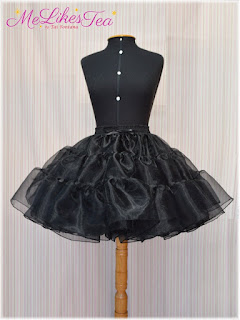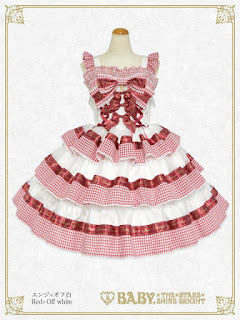The specifics of fabrics can often be confusing for lolitas, even experienced ones. Lolita material discourse typically centers around the primary polyester vs. cotton divide, with adherents on both sides. Rarely does the discussion cover the specifics beyond the fiber content. I've covered the basics of lolita fabric in my old school post series, in which I divided the identity of a fabric into four components: fiber content, weave, all-over dye, and print. Any fabric can come in any color or print, but weave and fiber content define a fabric.
Organza (and organdy, which is a variation thereof) is a tricky fabric to deal with. Despite having been a minor part of lolita since its inception, and having many uses, it's a real pain to sew with, and can fail in new and interesting ways that small-scale brands may have trouble managing. Because of this, organza was seldom used until after the OTT sweet boom. So, this unique textile is a perfect introduction to why fabrics are more than just an aesthetic choice.
Defining Organza
Organza is a lightweight, translucent, stiff, plain weave fabric made of polyester or silk that relies on smooth, untwisted filaments (very long fibers) to create a characteristic shiny effect. Plain weave is the simplest sort of weave in fabric-- it's the typical over-under alternation that kids learn in art class. Organza can also have grids woven in, but it's characteristically just plain woven. Organdy can refer to either a cotton variation of the fabric, or it can just be another name for organza. The vast majority of lolita brands use polyester organza, which is a lot less expensive, so when the fiber content isn't listed, it's pretty safe to treat it as poly. In general, the fabric is pretty inexpensive, which means it's fairly cheap to use yards and yards in a single project. Organza does not stretch.
The nature of organza makes it a beautiful pain in the petticoat to sew. The translucence of the fabric means that any seams and hems need to be sewn straight and enclosed entirely, because the raw edges of the fabric fray like an Amazon cosplay wig in a mosh pit. Organza also needs to be sewn with a special ballpoint needle, because regular needles can sever the threads of the fabric and cause visible snags and breakage. Even with the correct needle, the tiny puncture holes created by sewing into organza function like the perforations in a Graham cracker, meaning that these sewing lines concentrate the stress and can easily tear. Organza's stiffness and the typical polyester fiber content mean that creases and wrinkles can be irreversible, while routine ironing and pressing have a chance to melt the fabric into goo. Finally, organza's fragility means that over-pinning and resewing mistakes are out of bounds-- either the sewist gets things right the first time, or the fabric is doomed to the scrap pile.
Despite the many issues, organza has a ton of great applications in lolita to explore.
Structural: Petticoats
The lightweight stiffness of organza and relative low cost make it perfect for petticoats. Anecdotally, the most popular petticoat brands in lolita as of 2023 are Me Likes Tea and Aurora & Ariel, both of which use organza in at least some of their models.
Unlike other petticoat materials, the stiffness of organza makes it deflate very slowly, so it doesn't lose volume much over time. It's also soft and smooth on the skin, unlike stiff tulle. Still, most petticoats are lined-- warm layers and polyester lead to sweat that can't wick away, and nobody wants a sweaty petti! Because petticoats don't receive tension other than at the waist, the fragility of organza doesn't factor in, so it's a really excellent fabric for adding volume.
Organza as a Main Fabric
Despite its advantages in petticoats, organza doesn't always work well as a primary outer fabric. For one thing, skirts, dresses, and blouses not meant to be worn under a JSK need to be opaque. Organza's sheerness means that, in main pieces, it needs some serious lining in order to visually cover the body. This lining is also important because, being shiny polyester, organza against the body can get sweaty pretty easily. Many brands have used this to their advantage by strategically leaving sleeves and hems unlined, showcasing the delicacy of the fabric.
Organza has also been used in layering pieces like overdresses, where its translucence is a feature, not a bug. The delicate shine can add a lot of depth and formality to a coordinate.
Organza also works well when added to other textures and opacities, like with Baby's Sweet Best Wishes JSK, which has been released over and over.
But these are all low-stress applications, where the organza doesn't actually take much of the structural stress of the garment. Where there are points of stress, the organza is gathered or attached to another fabric, preventing it from tearing or trying to stretch. Because of this, organza performs poorly for a blouse fabric. Either blouses have to be fully lined, or they'll be fragile and prone to tearing. Additionally, organza needs a lot of ease for extra moving around room, and blouses tend to be closer fit than other lolita garments. Since lolitas typically wear our blouses under other items, a fully lined blouse can get a little toasty, but the sheer organza has summery vibes. Lolitas are at odds with the weather.
So, when buying or designing mostly-organza outer pieces, it's important to think of the fabric not just as a style choice, but as an engineering decision. Organza won't stretch. Organza also takes stress worse than a convention-goer in full con crunch. For durable, long-lasting lolita garments, keep those organzas stress free.
Accessorizing With Organza
This is the most foolproof use of organza. Organza ribbons and bows can add a princessy flair to lolita pieces without messing with the structural integrity. Organza has recently been especially popular in wristcuffs for sweet brands and in elaborate headresses for more OTT gothic applications. Strategic organza use can create ethereal, futuristic, and regal looks, and even cheap organza ribbon can look gorgeous when added carefully.
There are tons of interesting applications for organza as an accent material. I especially like organza accents in monochrome colorways where it can add visual interest through texture: kuro lolitas, your time is coming. Organza may be tricky to deal with, but it literally shines in the right accessories.
Conclusions
As someone who wears mostly clunky, frumpy styles, the ethereal shimmer of organza isn't really my vibe. I'm a big fan of organza petticoats (especially lined with cotton), and I adore the occasional organdy rose on a headdress, but billowing swaths of sheer layers aren't really my vibe, and I would never want a poly fabric like organza sitting directly in my armpit. When learning to add depth and visual interest to a coordinate, textural diversity is a must, and organza is an easy, breezy way for newer lolitas to play with shine and sheerness without resorting to iffy satin or itchy tulle. Additionally, this is one place in lolita where polyester stands out in a way that cotton just can't compete with. Over all, organza isn't an all purpose material, and it's certainly not beginner-friendly for DIY applications, but it definitely deserves a place in most modern lolita wardrobes.














No comments:
Post a Comment